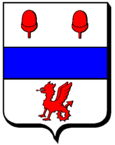Fossieux
| Fossieux | ||
|---|---|---|

|
|
|
| region | Grand Est | |
| Department | Moselle | |
| Arrondissement | Sarrebourg-Château-Salins | |
| Canton | Le Saulnois | |
| Community association | Saulnois | |
| Coordinates | 48 ° 51 ′ N , 6 ° 20 ′ E | |
| height | 189-258 m | |
| surface | 5.06 km 2 | |
| Residents | 219 (January 1, 2017) | |
| Population density | 43 inhabitants / km 2 | |
| Post Code | 57590 | |
| INSEE code | 57228 | |
 Sainte-Marguerite Church |
||
Fossieux is a French commune with 219 inhabitants (as of January 1, 2017) in the Moselle department in the Grand Est region (until 2015 Lorraine ). It belongs to the arrondissement of Sarrebourg-Château-Salins , to the canton of Le Saulnois and to the communal association Communauté de communes du Saulnois .
geography
Fossieux is located 31 kilometers southeast of Metz and 20 kilometers northeast of Nancy in Saulnois at an altitude between 189 and 258 meters above sea level between the neighboring communities of Aulnois-sur-Seille in the north, Chenicourt in the west and Arraye-et-Han in the south. The municipality covers 5.06 km² (506 hectares). The Seille flows west and south of Fossieux at Chenicourt and Arraye-et-Han. The nearest airport is Metz-Nancy-Lorraine Airport , 15.4 kilometers northwest of Fossieux.
history
Around 1286 the village was a fief of André d ' Amance , Seigneur de Bioncourt . The parish of Fossieux was subordinate to the Archpriest of Delme, who in turn was subordinate to the diocese of Metz . From the 13th century Delme had secular jurisdiction over Fossieux. In 1327 the village was mentioned as Foussues , in 1339 as Foussuelz , 1427 as Foussuelx and 1612 as Foussieux . In the 16th century Fossieux belonged to the Marquisate of Pont-à-Mousson and from 1698 to the Bailliage of Nomeny , which was dissolved in 1718. Nomeny belonged to the Duchy of Lorraine since 1612 .
In 1793 the village received the status of a municipality in the course of the French Revolution (1789-1799) and in 1801 the right to local self-government. Fossieux was part of the former Meurthe department , which was divided into the Moselle and Meurthe-et-Moselle departments in the Peace of Frankfurt in 1871 . The Peace of Frankfurt ended the Franco-German War (1870–1871). Fossieux was incorporated into the newly created realm of Alsace-Lorraine of the German Empire through this treaty . The realm of Alsace-Lorraine existed until the end of the First World War (1914–1918) and was then dissolved, Fossieux fell back to France. The division of the departments was retained and the municipality remained in the Moselle department. As a French-speaking village, Fossieux was one of the last 247 communities whose name was Germanized on September 2, 1915. The name was changed to "Fossingen" and was the official place name until 1918.
Population development
| year | 1962 | 1968 | 1975 | 1982 | 1990 | 1999 | 2007 |
|---|---|---|---|---|---|---|---|
| Residents | 115 | 118 | 118 | 113 | 141 | 149 | 162 |
coat of arms
The municipality's coat of arms is silver with a blue crossbar. This corresponds to the coat of arms of the Amance de Bioncourt family. The metallic color silver is represented in white in heraldry ( tinging ). In the upper area, the municipal coat of arms shows two red acorns and a red dragon at the top. The acorns are reminiscent of the monastery of Saint-Martin-de-Glandières (French: gland means "acorn") in Longeville-lès-Saint-Avold and the dragon is an attribute of the patron saint Margaret of Antioch .
Attractions
Fossieux Church was built in the 15th century, rebuilt in the 19th century and damaged in the First World War. It was classified as a Monument historique in 1920 .
Web links
Individual evidence
- ↑ Fossieux on Actuacity.com (French) Accessed on 5 May 2010
- ^ Fossieux on Annuaire-mairie.fr (French) Retrieved May 5, 2010
- ↑ Musée Barrois, Bar-le-Duc (ed.): Mémoires de la Société des lettres, sciences et arts de Bar-le-Duc . tape 5 , no. 3 , 1920, p. 582 (French, online [accessed May 6, 2010]).
- ^ Henri Lepage: Dictionnaire topographique du département de la Meurthe . In: Société d'archéologie lorraine et du Musée historique lorrain (ed.): Dictionnaire topographique de la France . 6th edition. tape 14 , no. 18 . Imprimerie impériale, Paris 1862, p. 40 + 53 + 103 (French, in Google Books [accessed May 5, 2010]).
- ↑ Comité des travaux historiques et scientifiques (ed.): Bulletin philologique et historique jusqu'à 1715 du Comité des travaux historiques et scientifiques . Imprimerie Nationale, 1922, ISSN 0399-5569 , p. 417 (French, online [accessed May 6, 2010]).
- ^ Fossieux at Cassini.ehess.fr (French). Retrieved May 5, 2010
- ↑ Les 247 dernières communes à noms français, débaptisées seulement le 2 septembre 1915 (French) Retrieved May 5, 2010
- ↑ Union of Cercles GENEALOGIQUES Lorrain (French) Accessed February 24, 2010
- ^ Fossieux in the Base Mérimée des Ministère de la culture (French). Retrieved on May 5, 2010
